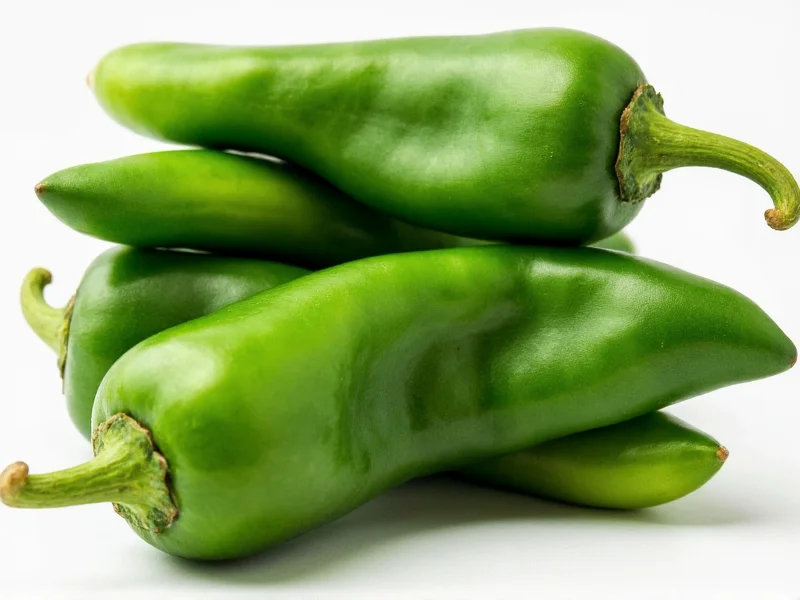When you need a jalapeño substitute for cooking, understanding heat levels and flavor profiles is essential for recipe success. Jalapeños measure 2,500-8,000 Scoville Heat Units (SHU) with a bright, grassy flavor that works well in salsas, nachos, and stuffed pepper recipes. Finding the right replacement depends on whether you need similar heat, milder options, or specific culinary applications.
Understanding Jalapeño Characteristics
Jalapeño peppers are medium-heat chilies with distinctive flavor notes that balance fruitiness and earthiness. Their heat level sits comfortably between bell peppers (0 SHU) and habaneros (100,000-350,000 SHU). The white pith and seeds contain most of the capsaicin, so removing these reduces heat significantly while maintaining flavor. Fresh jalapeños work best in raw applications like pico de gallo, while roasted versions add depth to sauces and stews.
Top Jalapeño Substitutes by Heat Level
Serrano Peppers: Closest Heat Match
Serranos (10,000-23,000 SHU) provide the most similar heat profile to jalapeños, though they're slightly hotter and fruitier. Use a 1:1 ratio when substituting in fresh salsas or guacamole. For raw applications, remove seeds and membranes to better match jalapeño heat. Serranos hold up well to cooking, making them ideal for jalapeño substitute in salsa verde or hot sauces.
Poblano Peppers: Milder Alternative
With just 1,000-2,000 SHU, poblanos offer a milder alternative to jalapeño while maintaining earthy flavor notes. Roast poblanos first to develop their complex flavor before using in place of jalapeños in stuffed pepper recipes or chili. Use 1.5 poblanos for every jalapeño called for in recipes requiring moderate heat. Their thick walls make poblanos excellent for chiles rellenos when jalapeños aren't available.
Cayenne Pepper: Dried Spice Option
When fresh peppers aren't available, cayenne pepper provides reliable heat control. The conversion ratio is critical: how much cayenne equals one jalapeño depends on your heat preference. Start with 1/8 teaspoon cayenne powder per medium jalapeño, then adjust to taste. Cayenne lacks the fresh pepper flavor but works well in cooked dishes like chili, soups, and marinades where texture isn't important.
Bell Peppers: Non-Spicy Alternative
For those seeking a non-spicy alternative to jalapeño peppers, bell peppers provide the same crunchy texture without heat. Use yellow or orange bells for slightly sweeter flavor that better matches jalapeño's fruitiness. In stuffed pepper recipes, combine bell peppers with 1/8 teaspoon cayenne or smoked paprika to maintain some complexity. Bell peppers work best when the recipe relies more on texture than heat.
Banana Peppers: Sweet Substitute
Banana peppers (0-500 SHU) offer a sweet alternative with minimal heat. Their tangy flavor works well in pickled applications or relishes where jalapeños would normally provide mild heat. Use a 1:1 ratio when substituting in cold dishes like salads or sandwiches. For cooked applications, add banana peppers later in the cooking process to preserve their delicate flavor.
| Pepper Type | Heat Level (SHU) | Flavor Profile | Best For | Substitution Ratio |
|---|---|---|---|---|
| Jalapeño (reference) | 2,500-8,000 | Grassy, bright, slightly fruity | Salsas, nachos, stuffed peppers | 1:1 |
| Serrano | 10,000-23,000 | Grassy, fruitier than jalapeño | Raw salsas, hot sauces | 1 serrano = 1-2 jalapeños |
| Poblano | 1,000-2,000 | Earthy, mild, slightly sweet | Stuffed peppers, chili, roasting | 1.5 poblanos = 1 jalapeño |
| Cayenne (powder) | 30,000-50,000 | Sharp, pungent | Cooked dishes, spice blends | 1/8-1/4 tsp = 1 jalapeño |
| Bell Pepper | 0 | Sweet, crisp | Stuffed peppers, salads | 1 bell = 1 jalapeño + pinch cayenne |
Specialized Substitution Tips
For jalapeño replacement for stuffed peppers, combine bell peppers with roasted poblano for flavor complexity. Remove seeds from all substitutes to control heat levels. When making pickled jalapeños, banana peppers provide similar texture with milder heat.
In salsas, serranos work best as a direct substitute, but add lime juice to balance their slightly higher heat. For cream-based dips like jalapeño poppers, use a combination of poblano and a pinch of cayenne to maintain flavor without overwhelming heat.
When substituting in baking applications like jalapeño cornbread, use 1/2 teaspoon smoked paprika plus 1/8 teaspoon cayenne per jalapeño for the closest flavor approximation without fresh pepper texture.
Adjusting Recipes with Substitutes
Always add heat gradually when using substitutes. Start with 75% of the recommended substitution amount, then taste and adjust. For raw applications, let substituted ingredients sit for 15 minutes to allow flavors to meld. In cooked dishes, add milder substitutes earlier in the cooking process to develop flavor, while hotter alternatives should be added later to prevent excessive heat extraction.
Remember that drying concentrates capsaicin, so dried pepper substitutes require significantly smaller quantities than fresh peppers. When converting recipes that call for canned jalapeños, use roasted poblano peppers with a splash of vinegar for similar tangy flavor.











 浙公网安备
33010002000092号
浙公网安备
33010002000092号 浙B2-20120091-4
浙B2-20120091-4